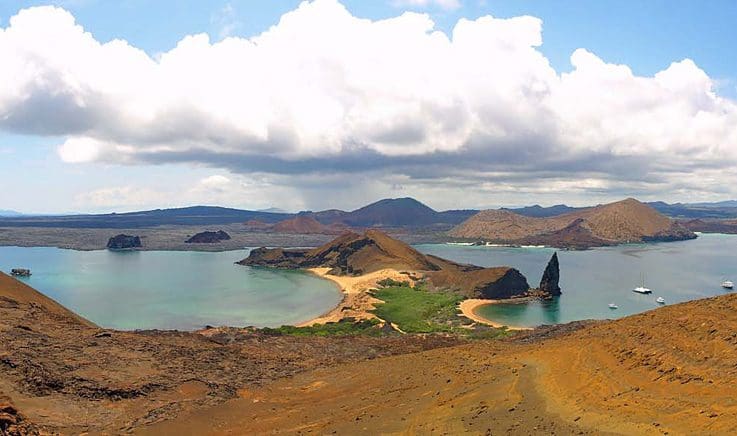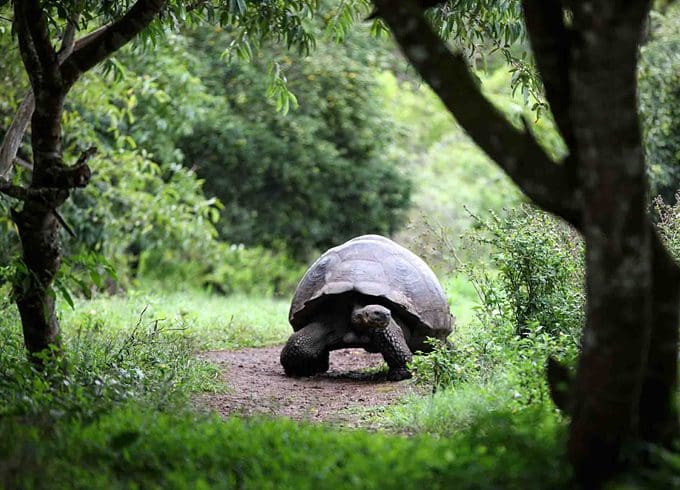words Alexa Wang
Only 270,000 souls per year are permitted travel to the evolutionary marvel that is the Galapagos Islands. Formed by volcanic activity and never a part of any continent, you can observe endemic species of birds, reptiles and marine life in natural habitats.
So if you are going to take this once-in-a-lifetime expedition, consider making it on a stylish, comfortable cruise ship and with naturalist guides who will see to it that you don’t miss one spectacular detail.
Luxe Accommodations
Harbored at Baltra Island, the Galapagos Legend is a 301-foot, four-deck expedition vessel, large enough to sail smoothly through the rough waters of the Pacific Ocean. With a 100-guest capacity, it is also small enough to be intimate and personable.
You’ll find your cabin warm and modern, and all cabins can convert to single, twin or double with more options on request. Some suites feature cabin-length panoramic windows, shared or private balconies, and there is one exclusive Legend Balcony Suite on the Moon Deck to make your extra-special occasion even more unforgettable. All cabins are outfitted for maximum relaxation and have private bathrooms and air conditioning to help you recuperate so that you’re ready for your next excursion.
Routes and Itineraries
Galapagos is truly a unique experience – you will see wildlife native only to the islands, and due to conservation efforts, natural environments as untouched as possible. Disembarking for day-trips usually flows quickly in small groups of no more than 16 and one of six multilingual naturalist guides. A dinghy will carry you from ship to island, and be ready for a wet-landing as sometimes the boats can only get as close as a knee-deep shoreline.
All itineraries have a moderate level of activity; hiking on beaches, across lava formations and plateaus, snorkeling and kayaking; and the treks will bring you intimately close to tame wildlife. Guides can customize the tours for family or other interests, and bring your camera – your friends at home will want to see this.
The regional routes (north and west, central and south) are comprised of 4-, 5- or 8-day itineraries, which can be mix-and-matched up to a 15-day tour of all Galapagos.
North Islands
Most routes begin at the Santa Cruz Highlands, where you can travel through the various Galapagos ecosystems like agricultural areas, thick rainforests and the mountains. The highlands are iconic for allowing visitors to see the famous Giant tortoises, but also appeal to bird-watchers, as almost every endemic species can be seen here. Other Santa Cruz visits include Dragon Hill and Bachas Beach, nesting grounds for the native land iguanas and sea turtles. From the beach, you can also see the wreckage of barges from the World War II-era United States Naval base on Baltra Island.
The next stop is often Santa Fe Island, home to an endemic cactus forest, and the only place you might see rice rats, one of the few rodents native to Galapagos. Of course the main attraction are the bright orange land iguanas that roam freely around the island.
On Genovesa Island, you’ll hike past at lava cliffs at El Barranco, which house many species of marine life. On the lava plain, if you’re lucky, you may spot a rare short-eared owl. Red-footed boobies live all over the island spread, but if you don’t see one anywhere else, you’ll find 200,000 of them at Darwin Bay.
West Islands
Mosquera Islet, consisting primarily of sand and lava rock, has almost no vegetation, and also no trails. You can wander freely, and it’s a prime location to view shorebirds like lava gulls and herons.
Sail on to Egas Port on Santiago Island, home to colonies of fur seals, yellow-crowned night herons and a striking black volcanic sand beach. Equally stunning is the dark red sand and geologically distinct volcanic remnants of Rabida Island, which is generally thought to be the epicenter of the islands.
You can see two structures put out of place on Isabella Island – a beached coral reef thrust onto land by a 1954 earthquake and pirate-made graffiti from the 19th century. An exceptionally diverse marine population can be found adjacent to Vicente Roca Point, and meet the tiny, 12-inch tall Galapagos penguins at Tagus Cove.
One of your last stops hosts one of the best examples of evolutionary isolation: Fernandina Island is home to likely the most primitive and the largest of the marine iguana species.
Central Islands
Central and south routes also start from Santa Cruz Island and the surrounding islets. These routes typically stop at the Charles Darwin Station, where Lonesome George (the last surviving Pinta Tortoise) lived. You will also find the base of the Galapagos National Park Services here, which contains a wealth of educational centers.
You might spend a couple of days on the islands north of Santa Cruz, walking the volcanic landscape on Bartolome Island, which looks eerily similar to the lunar surface. South Plaza, thickly covered with red Optunia cacti, is the only home for a few land and marine iguanas that have mated to form a hybrid. Another bird-watching hot spot is on North Seymour, where you can observe great frigatebirds and blue-footed boobies engaging in mating rituals.
San Cristobal Island has considerable ecological significance as Cerro Colorado is home to “La Galapaguera,” a semi-natural environment and breeding ground for giant tortoises from young to old. The Interpretation Center is the educational center of the Galapagos Islands, and you can learn a great deal about the formation of the islands, their evolutionary significance and how you can help conserve it.
South Islands
Española Island is home to the stunning beach at Gardner Bay, where the local sea lions will pay you absolutely no mind. At Suarez Point, you can wait for a perfectly-timed wave to hit the iconic blow-hole and shoot water into the air through the rock.
Leave a postcard in the same barrel where traders would leave letters to be picked up and carried to their families by colleagues headed home at Post Office Bay, Floreana Island. Marvel at the green volcanic crystal called olivine at the beach on Cormorant’s Point before you look for the greater flamingoes, growing as tall as five feet and obnoxiously pink. The last stop on Floreana is Devil’s Crown, where an eroded volcanic cone makes for unparalleled snorkeling. Swimmers have even reported sightings of hammerhead sharks.
Aquatic adventurers can view a seemingly endless variety of tropical fish and sharks at Ballena Bay and Eden Islet. If you haven’t yet taken advantage of the glass-bottomed boat, kayaks or snorkels, do it now while your land-loving counterparts play archaeologist and try to dig up settlers’ relics.
Shipboard Amenities & Evening Activities
Each evening, return to the vessel and soothe your sore muscles in one of two rail-side Jacuzzis while your kids splash in the pool. Let them hang out in their own special play-and-learn room while you chat with your fellow travelers in one of several comfortable outdoor or indoor gathering areas.
After all the exercise on the island, you’ll need to replenish your energy. Meet your family or new friends for unique Ecuadorian and international fare in either of the two restaurants or dine al-fresco at the outdoor grill. Enjoy a nightcap at the poolside bar, and get a good night’s sleep – there will be another island to discover tomorrow.
Book a cruise in Galapagos today to explore wildlife habitats and ecosystems unique to the islands. Make the journey on a vessel that can enhance your experience with style, comfort and educational expertise.







